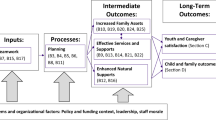Abstract
The wraparound process is emerging as an alternative to the traditional treatment planning processes inherent in categorical services for children and adolescents with emotional and behavioral disorders. We describe the current practices which have been developed in the field. Key elements of the value and philosophical base for the wraparound process are discussed. Proposed procedural steps are described to aid communities in the implementation of the wraparound process. Due to social and policy pressures, it is likely that wraparound process implementations will continue to develop.
Similar content being viewed by others
References
Burchard, J. D., Burchard, S. N., Sewell, R., & VanDenBerg, J. (1993).One kid at a time: Evaluative case studies and description of the Alaska Youth Initiative Demonstration Project. Washington DC: Georgetown University Child Development Center, CASSP Technical Assistance Center.
Burchard, J. D., & Clarke, R. T. (1990). The role of individualized care in a service delivery system for children and adolescents with severely maladjusted behavior.Journal of Mental Health Administration, 17, 48–60.
Burchard, J. D., & Shaefer, M. (1992). Improving accountability in a service delivery system in children's mental health.Clinical Psychology Review, 2, 867–882.
Clarke, R. T., Schaefer, M., Burchard, J. D., & Welkowitz, J. W. (1992). Community-based mental health services around children with a severe behavior disorder: An evaluation of Project Wraparound.Journal of Child and Family Studies, 3, 241–261.
Community Partnerships Group. (1995).Training manual on the Wraparound Process. Pittsburgh, PA: Authors.
Dennis, K., VanDenBerg, J., & Burchard, D. (April, 1992).The Wraparound process. Presented at the First National Wraparound Conference, Pittsburgh, PA.
Duchnowski, A. J., & Friedman, R. M. (1990). Children's Mental Health: Challenges for the nineties.Journal of Mental Health Administration, 17, 3–12.
Duchnowski, A. J., & Kutash, K. (1993, October).Developing comprehensive systems for troubled youth: Issues in mental health. Presented at the Shakertown Symposium on Developing Comprehensive Systems II, Shakertown, IL.
Franz, J. (1994). Barriers to cross-system integration: Dreams, challenges, strategies and hope in human services.The Calliope Journal, 3, 5–8.
Friedman, R. M. (1988). Individualizing services.Update: Improving services for emotionally disturbed children, 3(2), 10–12, 19.
Friedman, R. M. (1993) Preparation of students to work with children and families: Is it meeting the need?Administration and Policy in Mental Health, 20, 297–310.
Gossett, J. T. (1988). Treatment evaluation: A critical element in quality care of chronically ill youth. In J. G. Looney (Ed.),Chronic mental illness in children and adolescents (pp. 193–212). Washington, DC: American Psychiatric Press.
Jordan, D., Goldberg, M., & Goldberg, P. (1991).A guidebook for parents of children with emotional disorders. Minneapolis, MN: Parent Advocacy Coalition for Educational Rights (PACER Center).
Lourie, I. (1994).Principles of local system development for children, adolescents, and their families. Chicago, IL: Kaleidoscope.
Macbeth, G. (1993). Collaboration can be elusive: Virginia's experience in developing an interagency system of care.Administration and Policy in Mental Health, 20, 259–282.
National Mental Health Association. (1989).Final report and recommendations of the Invisible Children Project. Alexandria, VA: C. Ziegler-Dendy.
Sewell, R. (1990).What are some principal functions performed by an AYI Coordinator? Juneau, Alaska: Department Of Health & Social Services.
VanDenBerg, J. (1988). Alaska's services for children with emotional problems: A bright new hope.Coping, 3, 12–17.
VanDenBerg, J. (1993). Integration of individualized mental health services into the system of care for children and adolescents.Administration and Policy in Mental Health, 20, 91–112.
Whitbeck, J., Kimball, G., Olsen, D., Lonner, T., McKenna, M., & Robinson, R. (1993).An analysis of the interaction among systems, services and individualized and tailored care: A report from the field. Olympia, WA: Washington Division of Mental Health.
Author information
Authors and Affiliations
Rights and permissions
About this article
Cite this article
VanDenBerg, J.E., Mary Grealish, E. Individualized services and supports through the wraparound process: Philosophy and procedures. J Child Fam Stud 5, 7–21 (1996). https://doi.org/10.1007/BF02234675
Issue Date:
DOI: https://doi.org/10.1007/BF02234675




